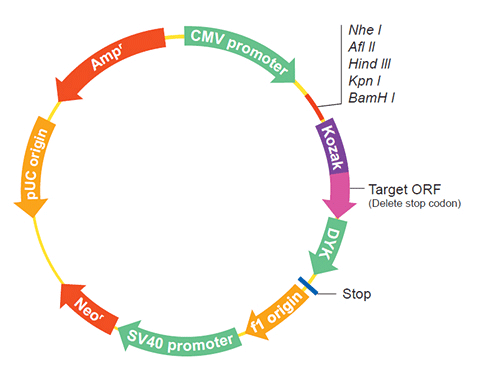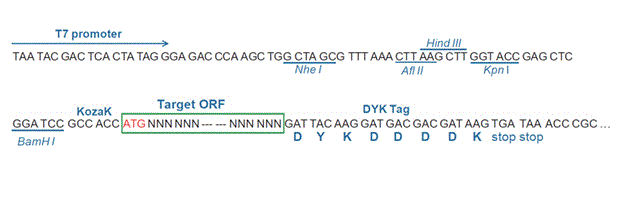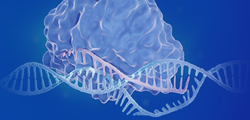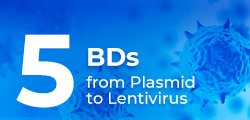| Gene Symbol | Cpap3-b |
| Entrez Gene ID | 408726 |
| Full Name | cuticular protein analogous to peritrophins 3-B |
| Synonyms | GB17664 |
| Gene Type | protein-coding |
| Organism | Apis mellifera(honey bee) |
-
REAGENT SERVICES
Hot!
-
Most Popular Services
-
Molecular Biology
-
Recombinant Antibody/Protein
-
Reagent Antibody
-
CRISPR Gene Editing
-
DNA Mutant Library
-
IVT RNA and LNP Formulations
-
Oligo Synthesis
-
Peptides
-
Cell Engineering
-
- Gene Synthesis FLASH Gene
- GenBrick™ Up to 200kb
- Gene Fragments Up to 3kb now
- Plasmid DNA Preparation Upgraded
- Cloning and Subcloning
- ORF cDNA Clones
- mRNA Plasmid Solutions New!
- Cell free mRNA Template New!
- AAV Plasmid Solutions New!
- Mutagenesis
- GenCircle™ Double-Stranded DNA New!
- GenSmart™ Online Tools
-
-
PRODUCTS
-
Most Popular Reagents
-
 Instruments
Instruments
-
Antibodies
-
ELISA Kits
-
Protein Electrophoresis and Blotting
-
Protein and Antibody Purification
-
Recombinant Proteins
-
Molecular Biology
-
Stable Cell Lines
-
Cell Isolation and Activation
-
 IVD Raw Materials
IVD Raw Materials
-
 Therapy Applications
Therapy Applications
-
Resources
-
- All Instruments
- Automated Protein and Antibody Purification SystemNew!
- Automated Plasmid MaxiprepHot!
- Automated Plasmid/Protein/Antibody Mini-scale Purification
- eBlot™ Protein Transfer System
- eStain™ Protein Staining System
- eZwest™ Lite Automated Western Blotting Device
- CytoSinct™ 1000 Cell Isolation Instrument
-
- Pharmacokinetics and Immunogenicity ELISA Kits
- Viral Titration QC ELISA Kits
- -- Lentivirus Titer p24 ELISA KitHot!
- -- MuLV Titer p30 ELISA KitNew!
- -- AAV2 and AAVX Titer Capsid ELISA Kits
- Residual Detection ELISA Kits
- -- T7 RNA Polymerase ELISA KitNew!
- -- BSA ELISA Kit, 2G
- -- Cas9 ELISA KitHot!
- -- Protein A ELISA KitHot!
- -- His tagged protein detection & purification
- dsRNA ELISA Kit
- Endonuclease ELISA Kit
- COVID-19 Detection cPass™ Technology Kits
-
- Automated Maxi-Plasmid PurificationHot!
- Automated Mini-Plasmid PurificationNew!
- PCR Reagents
- S.marcescens Nuclease Benz-Neburase™
- DNA Assembly GenBuilder™
- Cas9 / Cas12a / Cas13a Nucleases
- Base and Prime Editing Nucleases
- GMP Cas9 Nucleases
- CRISPR sgRNA Synthesis
- HDR Knock-in Template
- CRISPR Gene Editing Kits and Antibodies
-
![AmMag™ Quatro Automated Plasmid Purification]() AmMag™ Quatro automated plasmid purification
AmMag™ Quatro automated plasmid purification
-
![Anti-Camelid VHH]() MonoRab™ Anti-VHH Antibodies
MonoRab™ Anti-VHH Antibodies
-
![ELISA Kits]() ELISA Kits
ELISA Kits
-
![Precast Gels]() SurePAGE™ Precast Gels
SurePAGE™ Precast Gels
-
![Quatro ProAb Automated Protein and Antibody Purification System]() AmMag™ Quatro ProAb Automated Protein and Antibody Purification System
AmMag™ Quatro ProAb Automated Protein and Antibody Purification System
-
![Target Proteins]() Target Proteins
Target Proteins
-
![AmMag™ Quatro Automated Plasmid Purification]() AmMag™ Quatro automated plasmid purification
AmMag™ Quatro automated plasmid purification
-
![Stable Cell Lines]() Stable Cell Lines
Stable Cell Lines
-
![Cell Isolation and Activation]() Cell Isolation and Activation
Cell Isolation and Activation
-
 IVD Raw Materials
IVD Raw Materials
-
![Quick
Order]() Quick Order
Quick Order
-
![Quick
Order]() Quick Order
Quick Order
- APPLICATIONS
- RESOURCES
- ABOUT US
- SIGN IN My Account SIGN OUT
- REGISTER
ORF » Species Summary » Apis mellifera » Cpap3-b cDNA ORF clone
Cpap3-b cDNA ORF clone, Apis mellifera(honey bee)
-
Gene
-
Clones
gRNAs
-
Summary
-
mRNA and Protein(s)
mRNA Protein Name NM_001172378.1 NP_001165849.1 cuticular protein analogous to peritrophins 3-B precursor -
Pathways from BioSystems

-
Gene Ontology

-
Bibliography
Related articles in PubMed
Finding the missing honey bee genes: lessons learned from a genome upgrade.
Elsik CG, Worley KC, Bennett AK, Beye M, Camara F, Childers CP, de Graaf DC, Debyser G, Deng J, Devreese B, Elhaik E, Evans JD, Foster LJ, Graur D, Guigo R, , Hoff KJ, Holder ME, Hudson ME, Hunt GJ, Jiang H, Joshi V, Khetani RS, Kosarev P, Kovar CL, Ma J, Maleszka R, Moritz RF, Munoz-Torres MC, Murphy TD, Muzny DM, Newsham IF, Reese JT, Robertson HM, Robinson GE, Rueppell O, Solovyev V, Stanke M, Stolle E, Tsuruda JM, Vaerenbergh MV, Waterhouse RM, Weaver DB, Whitfield CW, Wu Y, Zdobnov EM, Zhang L, Zhu D, Gibbs RA,
BMC genomics1586(2014 Jan)Genes encoding proteins with peritrophin A-type chitin-binding domains in Tribolium castaneum are grouped into three distinct families based on phylogeny, expression and function.
Jasrapuria S, Arakane Y, Osman G, Kramer KJ, Beeman RW, Muthukrishnan S
Insect biochemistry and molecular biology40(3)214-27(2010 Mar)Insights into social insects from the genome of the honeybee Apis mellifera.
Nature443(7114)931-49(2006 Oct)Annotated expressed sequence tags and cDNA microarrays for studies of brain and behavior in the honey bee.
Whitfield CW, Band MR, Bonaldo MF, Kumar CG, Liu L, Pardinas JR, Robertson HM, Soares MB, Robinson GE
Genome research12(4)555-66(2002 Apr)GeneRIFs: Gene References Into Functions What's a GeneRIF?
The following Cpap3-b gene cDNA ORF clone sequences were retrieved from the NCBI Reference Sequence Database (RefSeq). These sequences represent the protein coding region of the Cpap3-b cDNA ORF which is encoded by the open reading frame (ORF) sequence. ORF sequences can be delivered in our standard vector, pcDNA3.1+/C-(K)DYK or the vector of your choice as an expression/transfection-ready ORF clone. Not the clone you want? Click here to find your clone.
-
Reference Sequences (Refseq)
CloneID OHd00405 Clone ID Related Accession (Same CDS sequence) NM_001172378.1 Accession Version NM_001172378.1 Latest version! Documents for ORF clone product in default vector Sequence Information ORF Nucleotide Sequence (Length: 885bp)
Protein sequence
SNPVector pcDNA3.1-C-(k)DYK or customized vector  User Manual
User ManualClone information Clone Map  MSDS
MSDSTag on pcDNA3.1+/C-(K)DYK C terminal DYKDDDDK tags ORF Insert Method CloneEZ™ Seamless cloning technology Insert Structure linear Update Date 1556812800000 Organism Apis mellifera(honey bee) Product cuticular protein analogous to peritrophins 3-B precursor Comment Comment: VALIDATED REFSEQ: This record has undergone validation or preliminary review. The reference sequence was derived from DB730045.1, BI507698.1 and DB770377.1. On Feb 16, 2010 this sequence version replaced XM_392261.3. ##Evidence-Data-START## RNAseq introns :: single sample supports all introns SAMN00008880, SAMN00113341 [ECO:0000348] ##Evidence-Data-END##
1
61
121
181
241
301
361
421
481
541
601
661
721
781
841ATGAAGACGG AGGTGTTGTG CCTGCTGATT TGTCTCGGCG CGGTCACCGG TTTGACGAGG
AAGCAAGAGG CGCTCGAGCA GAATCGTAGG AAAGTAAGTT CGCCAGTGTT GCAAAGGAAG
CAGCAGCAGC AGCAGCAATC CGCCGAGGAG GAGTATCAGG AGGACGAGGA AGAGGTATCG
GATCGATGTC CCGAGCCGAA CGGTTATTTC CCGGACGCGG GACAGTGCGA CAAATATTAC
GACTGTCGGG ACGGGAAATA TATAGAGAAA CTGTGCCCCG ACGGCCTAGT GTTCAACGAC
TTTAGCCCCC AACACGAGAA GTGCGATCTC CCGTTCGGAA TCGATTGCTC CAAGAGGCCG
AAATTGCAGA AACCGCAACC GTCCCCCCAT TGTCCAAGGA TGCACGGTTA CTTCGCCCAC
GAGGACACAA GAATATGCAA CACGTTCTAT TACTGCGTGG AGGGGAAGTT CAACATGATC
ACGTGCCCGG AGGGTCTGGT GTTCTCCGAG AAGACGGGTA TATGCAATTG GCCGGACGAG
GCGCAGAAGA AGGGTTGCGG TTCCAGGGAG TTGTTCAACT TCACTTGCCC GAGAGTGGAC
GAGGCGATCG CAGCGACCCA CCCGAGATAC CCGGACACCG AGGATTGCCA ATATTTTTAC
GTGTGCGTGA ACGGTGAGAT ACCGAGGAGG AGCGGGTGCA AGTTGGGGCA AGCGTTCGAC
GAGCGGACTG GAAAATGCGA CTGGGCGAGG AAGATACCCG AATGCAAAGA CTGGTACAAA
GGTCAATTGA CCGACGAGGA GTTGGACGCG TTGGAGAATC CGCCACCGAA GCCGAAACCG
AGTAGCGGTG GGCAGCACAG AAGGAAAGGC GCGAAACCGA CGTAGThe stop codons will be deleted if pcDNA3.1+/C-(K)DYK vector is selected.
RefSeq NP_001165849.1 CDS 175..1059 Translation 
Target ORF information:
RefSeq Version NM_001172378.1 Organism Apis mellifera(honey bee) Definition Apis mellifera cuticular protein analogous to peritrophins 3-B (Cpap3-b), mRNA. Target ORF information:
Epitope DYKDDDDK Bacterial selection AMPR Mammalian selection NeoR Vector pcDNA3.1+/C-(K)DYK  NM_001172378.1
NM_001172378.1
ORF Insert Sequence:
1
61
121
181
241
301
361
421
481
541
601
661
721
781
841ATGAAGACGG AGGTGTTGTG CCTGCTGATT TGTCTCGGCG CGGTCACCGG TTTGACGAGG
AAGCAAGAGG CGCTCGAGCA GAATCGTAGG AAAGTAAGTT CGCCAGTGTT GCAAAGGAAG
CAGCAGCAGC AGCAGCAATC CGCCGAGGAG GAGTATCAGG AGGACGAGGA AGAGGTATCG
GATCGATGTC CCGAGCCGAA CGGTTATTTC CCGGACGCGG GACAGTGCGA CAAATATTAC
GACTGTCGGG ACGGGAAATA TATAGAGAAA CTGTGCCCCG ACGGCCTAGT GTTCAACGAC
TTTAGCCCCC AACACGAGAA GTGCGATCTC CCGTTCGGAA TCGATTGCTC CAAGAGGCCG
AAATTGCAGA AACCGCAACC GTCCCCCCAT TGTCCAAGGA TGCACGGTTA CTTCGCCCAC
GAGGACACAA GAATATGCAA CACGTTCTAT TACTGCGTGG AGGGGAAGTT CAACATGATC
ACGTGCCCGG AGGGTCTGGT GTTCTCCGAG AAGACGGGTA TATGCAATTG GCCGGACGAG
GCGCAGAAGA AGGGTTGCGG TTCCAGGGAG TTGTTCAACT TCACTTGCCC GAGAGTGGAC
GAGGCGATCG CAGCGACCCA CCCGAGATAC CCGGACACCG AGGATTGCCA ATATTTTTAC
GTGTGCGTGA ACGGTGAGAT ACCGAGGAGG AGCGGGTGCA AGTTGGGGCA AGCGTTCGAC
GAGCGGACTG GAAAATGCGA CTGGGCGAGG AAGATACCCG AATGCAAAGA CTGGTACAAA
GGTCAATTGA CCGACGAGGA GTTGGACGCG TTGGAGAATC CGCCACCGAA GCCGAAACCG
AGTAGCGGTG GGCAGCACAG AAGGAAAGGC GCGAAACCGA CGTAGThe stop codons will be deleted if pcDNA3.1+/C-(K)DYK vector is selected.
-
PubMed
Finding the missing honey bee genes: lessons learned from a genome upgrade.
BMC genomics1586(2014 Jan)
Elsik CG,Worley KC,Bennett AK,Beye M,Camara F,Childers CP,de Graaf DC,Debyser G,Deng J,Devreese B,Elhaik E,Evans JD,Foster LJ,Graur D,Guigo R,,Hoff KJ,Holder ME,Hudson ME,Hunt GJ,Jiang H,Joshi V,Khetani RS,Kosarev P,Kovar CL,Ma J,Maleszka R,Moritz RF,Munoz-Torres MC,Murphy TD,Muzny DM,Newsham IF,Reese JT,Robertson HM,Robinson GE,Rueppell O,Solovyev V,Stanke M,Stolle E,Tsuruda JM,Vaerenbergh MV,Waterhouse RM,Weaver DB,Whitfield CW,Wu Y,Zdobnov EM,Zhang L,Zhu D,Gibbs RA,
Genes encoding proteins with peritrophin A-type chitin-binding domains in Tribolium castaneum are grouped into three distinct families based on phylogeny, expression and function.
Insect biochemistry and molecular biology40(3)214-27(2010 Mar)
Jasrapuria S,Arakane Y,Osman G,Kramer KJ,Beeman RW,Muthukrishnan S
Insights into social insects from the genome of the honeybee Apis mellifera.
Nature443(7114)931-49(2006 Oct)
Annotated expressed sequence tags and cDNA microarrays for studies of brain and behavior in the honey bee.
Genome research12(4)555-66(2002 Apr)
Whitfield CW,Band MR,Bonaldo MF,Kumar CG,Liu L,Pardinas JR,Robertson HM,Soares MB,Robinson GE
-
-
Most Popular Services
-
Services & Products
-
News & Blogs
- Boosting Transient Protein Expression-GenScript
- New Study Shows How Chimpanzees Can Spontaneously Learn
- Cell and gene therapy at GenScript Biotech Global Forum | GenScript
- New Targets in Treating Amyotrophic Lateral Sclerosis (ALS), a Neurodegenerative Disease, Identified Using CRISPR
- New competing theory to the ‘RNA-world’ hypothesis provides alternate, probable scenario for the origin of life
- First systemic delivery of CRISPR in large animals offers potential for treating fatal muscle disease
- CRISPR Based Transposon Silencing Leads to Infertility in Male Mice
- Maximizing Biofuel Production in the Yeast R. toruloides through Metabolic Engineering
-
-
-
PubMed
 Hi!Ask me about GenScript services and products! I can answer questions or connect you to a live person.
Hi!Ask me about GenScript services and products! I can answer questions or connect you to a live person. -




































